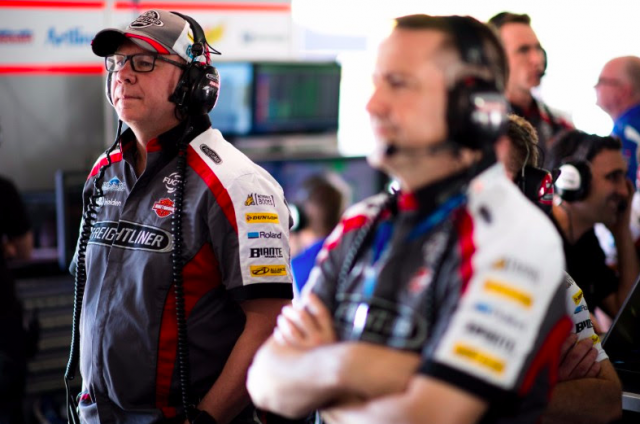
Brad Jones has broken his silence on the exclusion of its #75 entry from the Wilson Security Sandown 500 claiming the team complied with driving time regulations.
Tim Slade and Ash Walsh were stripped of a ninth place finish after stewards deemed Walsh had breached the minimum resting period of 54 laps.
Regulations dictate that drivers must effectively rest for a one third of the scheduled race distance (161 laps).
Sunday’s race was shortened to 125 laps after a lengthy red flag period following an opening lap crash, which is where the confusion stems.
After being turned around at the start of the race, Walsh drove for 86 of the 125 laps that were completed.
As a result, Walsh failed to meet the required effective resting period of 54 laps, having been out of the car for 39 laps.
Regulations dictate that drivers must effectively rest for a one third of the scheduled race distance (161 laps).
Brad Jones Racing argues that its drivers met the required resting period with its interpretation of the rule.
The regulations in question read as the following;
“8.4.6.1 the total driving distance for each Driver must not exceed two-thirds (2/3) of the scheduled race distance; and
“8.4.6.2 the total effective resting time for each Driver must be equal to at least one-third (1/3) of the scheduled race distance.
“8.4.6.3 the scheduled race distance will always be considered as the number laps listed in the Supplementary Regulations, irrespective of a time certain finish being referenced and/or applied unless, at the sole discretion of the Stewards, a reduced distance is necessary.”
The Albury squad elected against appealing the decision but has released a lengthy statement today outlining their case.
A statement from Brad Jones Racing
BJR was charged with not complying with section 8.4.6.2 of this rule. BJR’s interpretation of this rule is as follows.
8.4.6.1: Two-thirds (2/3) of the scheduled race distance (161 laps) equals 107.3. So, no driver can do more than 107 laps out of 161.
•Walsh: Completed 86 laps. Complies with rule.
•Slade: Competed 39 laps. Complies with rule.
8.4.6.2: Each driver must effectively rest (not be driving the car) for one-third (1/3) of the scheduled race distance (161). So, each driver must be out of the car for more than 54 laps out of 161.
•Walsh: Effectively rested 75 of 161 laps. Complies with rule.
•Slade: Effectively rested 122 of 161 laps. Complies with rule.
8.4.6.3: Defines that all driving times are calculated off the laps detailed in the Supplementary Regulations (161 laps) regardless of the time certain finish (16:48 for Sandown).
The team are standing by the fact that nowhere in this rule is there reference to the ‘actual’ or ‘completed’ race distance.
BJR feel the intent of the rule is so that teams can plan strategy on a defined race length, which is why the rule references on more than one occasion, the ‘scheduled race distance.’
Further to this, the team have discussed the rule in length and have agreed a team would find it near impossible to plan or complete a strategy guessing what the eventual race laps would be.
For example, another red flag or even more safety car laps would have shorten the 2017 race even further.
So, if BJR had have pitted Walsh 54 laps before the end of the actual 125 laps, one more safety car period in Slade’s stint would have reduced the race by at least 1 lap, meaning he would not comply with 8.4.6.2 as interpreted by the Stewards. How are teams expected to predict the future?
Another example would have been if the red flag was at the other end of the race. Most teams would have driven their co-driver for two stints (82 laps) before swapping to their main driver (to achieve minimum race stops of 41 lap fuel stints).
A shortened race to 125 laps would mean all these cars would have not complied with 8.4.6.2 as interpreted by the Stewards.
If the race above did happen, the Stewards would have the discretion to reduce the race distance.
However, the teams that took the gamble or guessed that the race could be shortened may have run a compromised strategy to do so.
If the stewards then reduce the race length after the fact, then this seems unfair to those teams.
Hence, using ‘scheduled race distance’ is the only way teams can plan and execute strategy and why the wording is used extensively throughout the rule.
“We are really disappointed at the weekends penalty for Tim & Ash,” added Brad Jones.
“To appeal this decision was going to be $11,000 plus our costs and you have one hour to submit the paperwork to do this after the hearing.
“At that point, which was around 7.30pm on Sunday evening it is difficult to seek the correct legal advice. We felt that we would accept the decision that was made, even though it was a pretty bitter pill to swallow.
“We’ve got a lot of work to do at BJR in the next couple of weeks, and I’m eager to put the Sandown weekend behind us.
“This has undoubtedly been one of the toughest seasons for us.
“If we can stand on the podium at Bathurst, it would be the ultimate reward for the team and all their efforts and hard work they’ve put in this year.”






















Discussion about this post